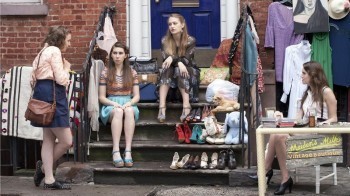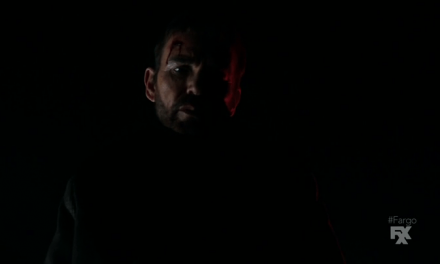
I was surprised to hear from the editor of CSTonline that no one had yet covered the topic of this week’s blog, the HBO comedy drama series Girls (2012-), created by and starring Lena Dunham. Surprised because the series, following the lives of a group of white, middle-class women in their twenties who live in New York City, has been met with both a huge amount of critical acclaim and a seemingly equally huge amount of critical scorn, particularly from what is rather irritatingly known as the ‘blogosphere’. The main criticism of Dunham’s work (many of the negative blogs are collated here) was that the narrowness of its representation of white, educated, privileged women was objectionable: for example, Jenna Wortham wrote in The Hairpin ‘My chief beef is not simply that the girls in Girls are white … The problem with Girls is that while the show reaches — and succeeds, in many ways — to show female characters that are not caricatures, it feels alienating, a party of four engineered to appeal to a very specific subset of the television viewing audience, when the show has the potential to be so much bigger than that’. Whilst for some Girls succeeded in offering a more honest and realistic representation of metropolitan womanhood than its obvious point of comparison, Sex and the City, particularly in depicting the messiness and disfunctionality of their sexual and romantic relationships, for others the show failed as a feminist text because of its lack of women of colour, or of more diverse class backgrounds. I don’t intend to get into the nitty-gritty of the history of this argument here, partly because I’m looking forward to hearing Faye Woods’ account of it at the Television for Women conference at Warwick in May. However, I do want to consider my own engagement with the programme in a bit more detail, and to relate it to another recent UK comedy drama which I’ve also recently enjoyed.
At present I watch very little television. I have a young family which means that I often have to leave work by about 4.30pm and begin work again at 8.30pm when the kids are asleep, dinner has been cooked, washing sorted and so on. This means that prime-time is no longer TV prime-time for me and, like Karen Lury, I worry about ‘keeping up with the medium’ on which I have based my career. It can often feel, as it did for me around both The Wire (HBO, 2002-2008) and Mad Men (AMC, 2007-), as if I am losing a grip on television by not seeing key shows that ‘everyone’ in academia and beyond is talking/teaching/writing about. I therefore made a rather conscious decision to follow Girls when its broadcast on Sky Atlantic was announced last year; I knew it had already received all this attention even before its first broadcast in the States, and also, as someone who is currently working on a project which focuses on the idea of ‘television for women’, I felt that I should check out what seemed to be the latest incarnation of the female ensemble drama. I have consistently watched the series in a very specific context: always a day after its initial broadcast, in the late evening, and with my mum. This is significant in the sense that neither of us would be seen as Girls’ target audience: my mum is in her mid-sixties, lives in the north east of England (when she’s not at my house helping my look after my kids), and is no more a member of NYC’s ‘hipster class’ than I am. I am in my late thirties, live in the Midlands, and am an academic and mum. However, watching Girls together grew to become something of a weekly highlight.
At risk of re-treading a well-worn path, what we both liked about Girls was, indeed, its honesty. This is firstly reflected in its narrative explorations of Hannah, Marnie, Shoshana and Jessa’s friendship with each other, which often teeters on the brink of being damaged by Hannah’s self-obsession.

Hannah, played by Dunham, is the solipsistic writer at the centre of the narrative who lives in a permanent state of angst. Hounded by the need to self-analyse, unable to become properly independent from her parents, and slipping into an increasingly disturbed mental state by the end of the second season, there is a particular rawness to this character as written and played by Dunham. We repeatedly see her in intimate settings or undertaking intimate activities: on the toilet, picking her nose, pulling her knickers out of her bum, stumbling awkwardly down the street, ‘over sharing’ in casual and professional encounters, demonstrating obsessive-compulsive behaviours, having sex in increasingly graphic scenes, and even being peed on by her on-off boyfriend Adam in the shower:
https://youtube.com/watch?v=zVEz-6sWAMc
This scene also represents the other form of honesty which my mum and I found so appealing about the show: its nudity. This feels like an odd thing to say; certainly, finding pleasure in the representation of the naked or semi-naked body on television (often via film/DVD) is more usually equated with the scopophillic pleasures of pornography. However, in relation to Girls, enjoying the increasingly visible sight of Lena Dunham’s naked body felt more about a stand being taken against the hard bodies of pornography or the perfected and airbrushed bodies of Hollywood starlets. Again, Dunham’s body has been blogged about on an industrial scale. Responses range from accusations of exhibitionism to heralding Dunham’s body-positivism as ‘revolutionary’. Words like ‘unflinching’ and ‘defiant’ and even ‘ballsy’ are used to describe the ways in which Dunham presents her own body. However, what strikes me is not that Dunham’s weight (her body is soft, curvy, a bit jiggly in places, but not massively overweight as some of the reviews would have us believe) is a central issue of the series, but that it is not. Her body is not discussed (often) in the series, but it is visible: we see it when she’s fucking, but also when she’s walking around her apartment, or getting dressed, or in her bathroom, as in this scene when Jessa (Jemima Kirke) walks into Hannah’s apartment after the breakdown of her marriage:
[APOLOGIES, VIDEO NO LONGER AVAILABLE]
https://youtube.com/watch?v=PiRh3ry-shQ
My response to this scene and the series as a whole, especially in the depiction of these women’s manifestations of angst, neuroses, and their struggles with relationships (both romantic and friendship-based), has led me back to Ien Ang’s work on Dallas in the early 1990s, and particularly to her analysis of the figure of Sue Ellen and the ways in which the viewers at the centre of her audience study related to this character. Ang developed the notion of ‘emotional realism’ to explain the fact that whilst Dallas was not understood as being ‘realistic’ on a denotive level (i.e. recognisably reflective of the everyday lives of the viewers she spoke to about the programme in the Netherlands), it was on a connotative level, in that viewers in variety of settings and contexts could recognise and identify with the emotions experienced by characters, particularly in relation to their familial and romantic relationships. As Ang says ‘what is recognised as real is not knowledge of the world, but a subjective experience of the world, a “structure of feeling”.’ In the bath-tub scene above, I identify not with the funky New York apartment, or the hipster tattoos, or the chunky boho jewellery, but the solidness of friendship in this moment, Jessa’s need to get close to someone who knows and understands her, and the intimacy of their shared moment (complete with shared bodily fluids!). Girls centralises female friendship in a ‘warts and all’ depiction that shows women both supporting each other and driving each other mad (as seen in this Season 1 clip):
So I guess this is why, for me and my mum, the criticisms of ‘narrowness’ levelled at Girls seem unfair. Do we need to see a mirror image of ourselves on screen in order to appreciate the brilliance of a drama’s depiction of people and relationships? Certainly Ang’s work would suggest not.
In 2013, we frequently watched Girls in a double-bill with E4’s comedy drama series My Mad Fat Diary, based on the published teenage diaries of Rae Earl. At the centre of this drama, Rae (Sharon Rooney) is depicted as struggling with her body image whilst simultaneously coming to terms with her sexuality and her desire to get a boyfriend; released from hospital following a suicide attempt at the start of the drama, the confessional diary form (coupling animated text and images from the eponymous diary with Rooney’s voiceover) encourages a similar sense intimacy and honesty in the representation of neuroses and female desire as Girls does.
Rae, like Hannah, is figured as both desiring (the fantasy sequences focused on the object of her desire, Finn (Nico Mirallegro) are often both inventive and funny) and desirable, despite being ‘mad’ and ‘fat’ as the title suggests. Again, in the context of previous film and television depictions of female sexuality, this feels rather radical (a colleague showed the first episode to her students last week and was met with a cry of ‘Why would we want to watch a drama about some girl who is so fat and ugly?’ – clearly persuading all viewers of the importance of the extension of representation of different forms of femininity has some way to go….). I am probably closer to the target audience for My Mad Fat Diary than Girls. Unlike the book/diary it is based on, the drama is set in the mid-90s and simultaneously appeals to E4’s teenage target audience and a nostalgic viewer who remembers the music that features so heavily in its soundtrack, or recognises the fashion trends and cultural events depicted on screen (dodgy raves accompanied by even dodgier pharmaceuticals, Oasis at Knebworth, and so on). I was in my early-twenties in the period in which My Mad Fat Diary is set, not living far from its Lincolnshire setting: both the place and time of this series are very familiar to me. However, these points of recognition and the denotive realism of My Mad Fat Diary are again less significant that its emotional realism (the strategies of intimacy mentioned above almost force us into an identificatory relationship with Rae). So I guess this blog is about how these television programmes have made me feel (possibly not a very cool or ‘scholarly’ topic in some circles). In the context of my current research project, which has explored dramas (and other programmes) made for, appreciated by, and often featuring women, the feelings of pleasure, elation even, in the depiction of desiring and desirable women who don’t fit the ‘conventional’ mould either physically or mentally, shared and talked about and enjoyed with my mum, seemed important.
Helen Wheatley on behalf of the ‘A History of Television for Women, 1947-89’ team: Hazel Collie, Mary Irwin, Rachel Moseley, Helen Wheatley, Helen Wood.
Helen Wheatley is Associate Professor in Film and Television Studies at the University of Warwick. She has published widely on popular genres in television drama in the UK and US (particularly the studio-based drama of the 1960s and 70s), and is the author of Gothic Television (MUP, 2006). She has an ongoing interest in issues of television history and historiography, and edited Re-viewing Television History: Critical Issues in Television Historiography (IB Tauris, 2007). Helen is currently writing a book on the notion of television spectacle and visual pleasure. She is co-investigator on the AHRC project A History of Television For Women in Britain, 1947-1989.




